Potted chrysanthemum, what it is, rules of care, pruning, wintering and propagation
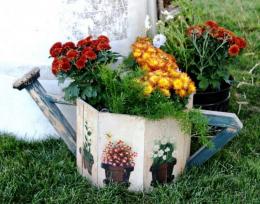
Today, many people decorate their home with fresh flowers, using various types and varieties. Potted chrysanthemum is very popular.
In order for a flower to always delight its owner with its beauty, it is important to know how to care for it, what to avoid and not allow. Let's figure it out now.
Content:
- Potted chrysanthemum - what varieties can be grown, description, photo
- If you gave a chrysanthemum in a pot - how to care for it, care after purchase
- Is it necessary and how to pinch a chrysanthemum in a pot?
- How to trim a bush correctly
- What to do if chrysanthemum does not bloom
- What to do if a chrysanthemum in a pot withers, how to revive it
- Features of care after flowering
- Reproduction
- Storing plants in winter
Potted chrysanthemum - what varieties can be grown, description, photo
Height chrysanthemums does not exceed seventy centimeters, the minimum height is fifteen centimeters. Flowers can be small or, on the contrary, large, it all depends on the type and variety.
The same can be said about the colors of the buds; they are so varied that it is difficult to name all the colors. Chrysanthemums can be divided into two types: mulberry and Chinese.
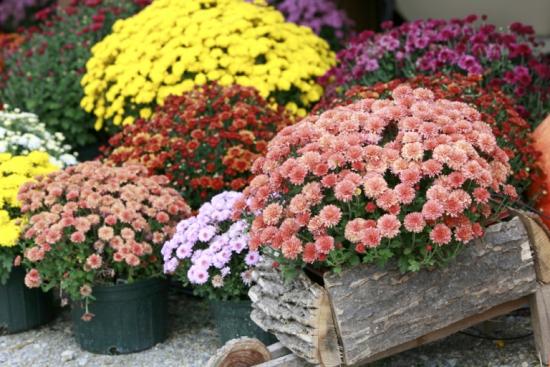
Popular varieties:
- Charm. This type has the shape of a hat or basket; the color palette is multifaceted.
- Variety Minimum - bush dwarf flowers, maximum height - twenty centimeters.
- Cascade - small chrysanthemums of an ampelous shape.
- Indian variety: "Helen", "Snow Elf", "Altgold", "Aurora". These flowers are actively planted in winter gardens, greenhouses or at home, on glazed balconies or window sills.
- Korean spherical, this includes varieties: Navare, Orange Jam and Stella. The shape of the inflorescences resembles beautiful balls, hence the name, spherical chrysanthemums.
Each owner or housewife must independently choose a variety, because each of them differs in the size of flowers, bushes, color and shape. But the care is the same for everyone.
If you gave a chrysanthemum in a pot - how to care for it, care after purchase
After purchasing a houseplant, it is important to leave it for a short period of time to adapt.
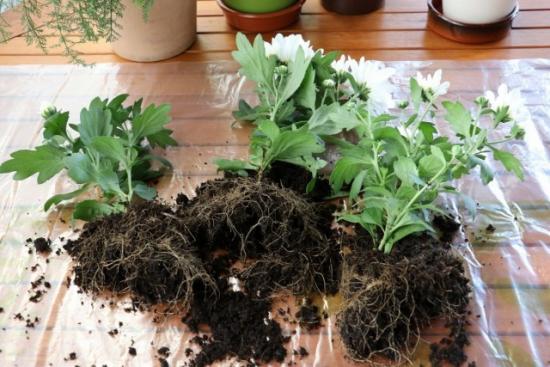
The flowerpot should be placed on a windowsill where there is enough light, but the flower should be protected from direct ultraviolet rays. For 14 days it is completely at rest, watering is carried out if necessary. Don’t worry if the flowers dry out a little or the leaves fall off; this is normal during the adaptation period.
After the specified period the flower can be replanted, for replanting it is better to use special soil with the addition of peat. Replanting is not carried out if the plant is blooming; in this case, you need to wait until the flowering period ends.
For the procedure, use a flowerpot several centimeters deeper and wider than the previous one.
New soil, even purchased, must be disinfected with boiling water or a solution of potassium permanganate. Use the soil when it dries.
It is important not to forget to do drainage. Then fill it with the nutrient mixture. Transplantation is carried out by transferring from a flowerpot to a new pot.
The day before transshipment, water the plant well.Constantly monitor the condition of the ground. Do not allow the soil to dry out or flood. Watering is carried out approximately twice a week. Settled water is used. If there is excess water in the pan, it must be poured out. If the room is not hot, then it is enough to water the chrysanthemum once every 7 days.
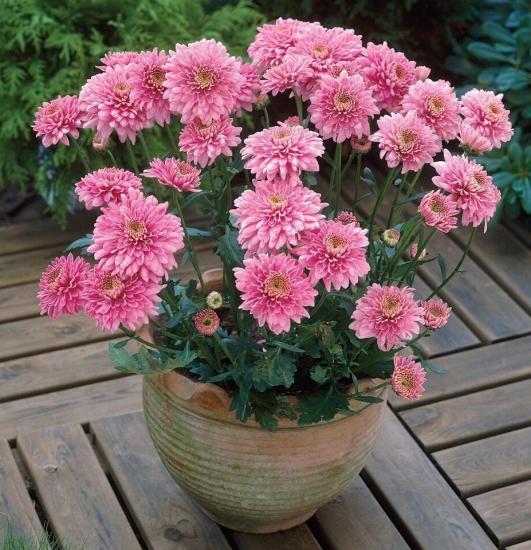
Lighting plays an important role. The flower loves light; if there is not enough light, this will negatively affect the duration of flowering and the number of buds.
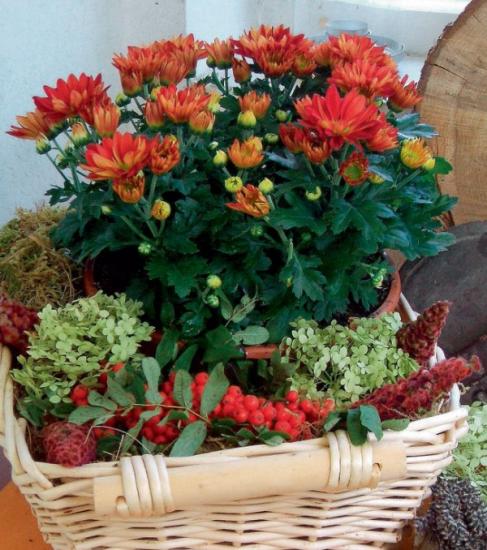
Temperature regime. The ideal temperature is 15 degrees. The temperature in the room where the plant grows should not exceed 18 degrees, otherwise problems will begin with the growth and appearance of the flower.
The last step is feeding. After purchase, there is no need to add fertilizer for a month. In the future, an adult flower needs feeding before the formation of buds and after winter dormancy. Organic matter and minerals are used as fertilizer: potassium and magnesium.
Now it’s worth thinking about pruning and propagating the flower.
Is it necessary and how to pinch a chrysanthemum in a pot?
Pinching is mandatory. This manipulation prevents the plant from stretching, but helps create a beautiful shape and grow in width.
The top is pinched once in the spring, and several times in early summer. The last procedure is performed several weeks before the buds open, which approximately falls in the last days of August. In this case, the flower directs all its forces not to growth, but to flowering.
How to trim a bush correctly
Pruning is carried out for two purposes:
- To form a bush. In this case, it is necessary to remove the crown and slow down the growth of the chrysanthemum.Using a sharp tool, pruning shears or knife, cut off the upper part, on which there are up to 4 leaves. Thanks to this, the root system will be strengthened and side shoots will grow. This procedure is carried out 15 days (at least ten) after the transplant. At the end of pruning, the chrysanthemum is watered with nitrogen. If the manipulation was carried out correctly, then on the fourteenth, maximum twenty-first day, new shoots should appear.
- Prepare the flower for winter holidays. In this case, the stem is cut off as much as possible, leaving no more than 10 cm. The plant is inspected to look for damaged or diseased branches; if necessary, they must be removed. Thanks to high-quality pruning, the chrysanthemum will rest, and this will contribute to good flowering and growth in the future. After the procedure, the flowerpot is placed in a cool room until March.
It is recommended to use a tool treated with potassium permanganate for pruning and avoid sudden movements.
What to do if chrysanthemum does not bloom
If the flower is healthy, then buds will definitely appear in the fall. If this did not happen, then errors were made during care.
For example:
- lack of light. It is important that the plant receives the required amount of light for at least seven hours a day;
- pruning or pinching was not carried out in a timely manner;
- lack of fertilizers, first of all, this indicates a lack of potassium and phosphorus.
If all problems are eliminated and care is normalized, the chrysanthemum will begin to bloom as before.
What to do if a chrysanthemum in a pot withers, how to revive it
If the foliage or buds begin to wither, this indicates excessive watering, high air temperatures, or an attack by pests.
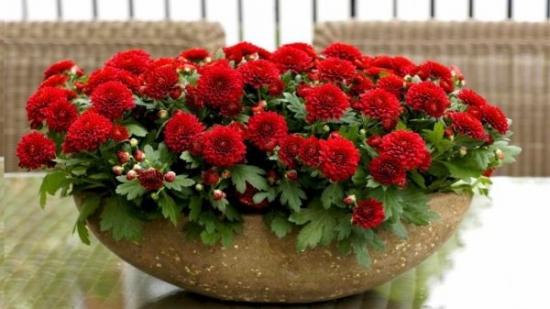
If, after a full check, no errors were found during care, then the flower must be completely dug up to see the condition of the root system. If rot is detected, all damaged roots should be removed and the plant transplanted into a new pot with good, fertilized soil. After transplanting, do not water the flower for a couple of days.
Features of care after flowering
After dropping all the flowers and the end of the flowering period, it is important to trim the flower so that only stumps remain, 5, maximum 10 cm high. This will help the chrysanthemum to recover as much as possible during the dormant period. Leave the flowerpot in a room where the temperature is not higher than plus 2 degrees, but not less than -3 degrees.
During this period, you should not introduce fertilizing or fertilize the soil. After flowering, the flower is watered once every 2 weeks.
When new shoots appear, transplant the plant into a new pot and return it to its original place.
Reproduction
For beginners, it is better to use the division method for propagation. During the replanting period, the bush is divided and replanted in different flowerpots. If the roots were injured during the procedure, they must be treated with crushed coal before planting.
The second propagation method is cuttings. Take green cuttings, the length of which is no more than 10 cm. You can put the cuttings in water or bury them directly in the ground. In both cases, it is necessary to tear off all the lower leaves.
If you choose rooting in water, then replanting into a pot can be done when the roots grow to 4 cm, or more.
If the second method was used, rooting in the ground, then the top of the cutting is closed with a glass jar or covered with a plastic bag.
Every day the bag or jar is opened to ventilate the soil and the shoot.When the condition of the leaves and stem is restored, it means that the roots have strengthened and the film can be removed. To speed up the growth of the cuttings, pinch off the top.
Storing plants in winter
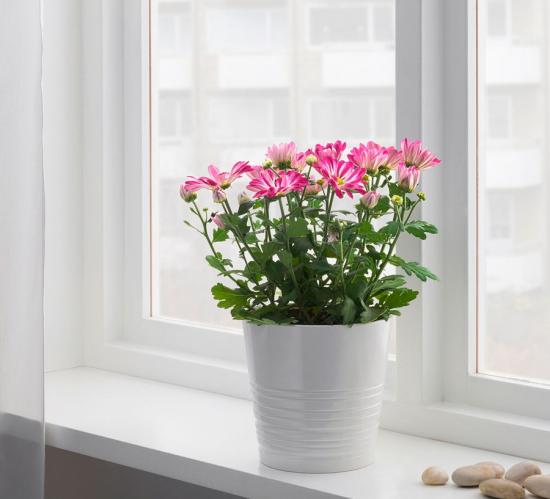
Can be stored under the following conditions:
- In the basement. Before sending the flower to the basement, you need to remove all damaged flowers and twigs and trim them. Carry out watering in a few days.
- In the entrance or on the veranda. It is advisable that the temperature should not be lower than -3 so that the plant does not freeze. Watering is carried out extremely rarely; it is necessary to ensure that the soil does not dry out to a depth of two fingers. Watering is carried out approximately once every 30 days.
- On the windowsill of the house. This option is possible if there is no cool room. You should trim the flower, leaving no more than 5 centimeters, and monitor its condition throughout the winter.
So, chrysanthemum is a beautiful house plant that requires special attention and care. If you follow all the recommendations, the flower will delight the owner for a long time with its irresistible buds.


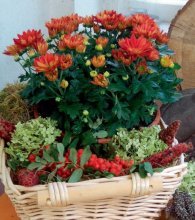

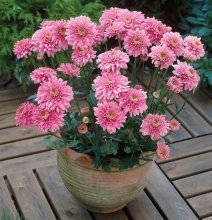
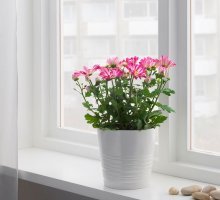
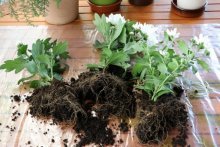
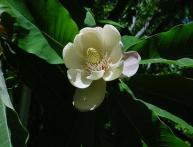







Comments
Sometimes a chrysanthemum may not bloom not only due to illness, but also as a result of incorrect fertilizing. For example, if you fertilize a bush only with nitrogen-containing products, the result will be rich and lush greenery, but completely without buds. When buds begin to form, it is worth feeding the plant with a complex product with a predominance of potassium and phosphorus.
We only grow chrysanthemums in flower beds and they all bloom together starting in August. After chrysanthemums have bloomed, we never cut off the stem. I'll try this year, maybe next year the flowers will be bigger?